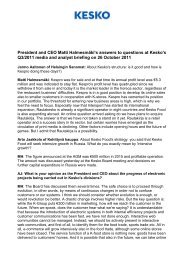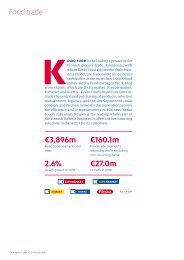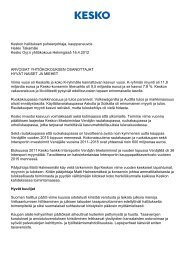Pdf version (3.2 MB) - Kesko
Pdf version (3.2 MB) - Kesko
Pdf version (3.2 MB) - Kesko
Create successful ePaper yourself
Turn your PDF publications into a flip-book with our unique Google optimized e-Paper software.
DEFINITIONs OF TERMs aNd<br />
THE BOuNdaRIEs<br />
the text and graphs contain terms and indicators whose contents are explained below.<br />
Return on equity, % =<br />
Return on capital employed, % =<br />
Equity ratio, % =<br />
Gearing, % =<br />
(Profit/loss before tax – income tax)<br />
Shareholders’ equity<br />
Operating profit<br />
(Non-current assets + inventories + receivables + other current assets<br />
– non-interest-bearing liabilities) for a 12-month average<br />
Shareholders’ equity<br />
(Balance sheet total – prepayments received)<br />
Interest-bearing net debt<br />
Shareholders’ equity<br />
Market capitalisation = Share price at balance sheet date x number of shares<br />
Earnings/share, diluted =<br />
Profit/loss – non-controlling interests<br />
Average number of shares adjusted for the dilutive effect of options<br />
Primary energy = Available in resources in their natural state; divided into renewable and non-renewable energy<br />
GWh = Gigawatt hour = a million kilowatt hours (kWh)<br />
1 kWh = 3.6 MJ = 3,600 kJ (in GRI guidelines, the unit for measuring energy is joule, or J)<br />
CO 2 = Carbon dioxide = causes climate change (‘greenhouse effect’)<br />
CO 2 e =<br />
Carbon dioxide equivalent, the amount of different gases whose combined impact on<br />
the greenhouse effect corresponds to the amount of carbon dioxide mentioned<br />
SO 2 = Sulphur dioxide equivalent, affects acidification<br />
C 2 H 4 = Ethene, affects the ozone content of the lower atmosphere<br />
Sickness absence/<br />
million working hours<br />
Sickness absence percentage =<br />
Employee departure turnover =<br />
Injury rate/<br />
million working hours<br />
=<br />
= Number of injuries 1 Jan.–31 Dec.<br />
Sickness absence 1 Jan.–31 Dec.<br />
Theoretical regular working time 1 Jan.–31 Dec.<br />
Sickness absence 1 Jan.–31 Dec.<br />
(Number of hours worked 1 Jan.–31 Dec. + absence period)*<br />
Number of departures 1 Jan.–31 Dec. (excluding summer employees)<br />
Number of personnel at 31 Dec.<br />
Number of hours worked 1 Jan.–31 Dec.<br />
* Calculation formula established at <strong>Kesko</strong>. For units whose hours worked are not known, calculation uses the theoretical regular working time.<br />
DEFINITIONs OF TERMs<br />
x 100<br />
x 100<br />
x 100<br />
x 100<br />
x 1,000,000 hours<br />
x 100<br />
x 1,000,000 hours<br />
<strong>Kesko</strong> Corporate Responsibility Report 2011 91















